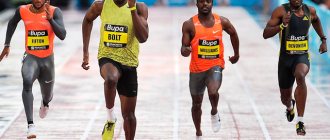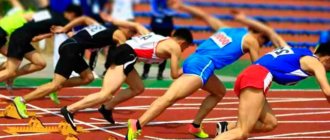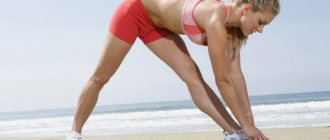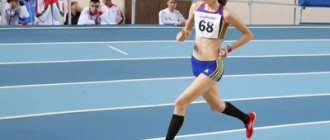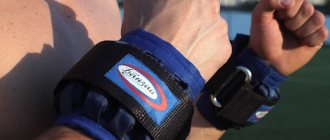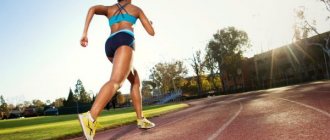Any type of athletics is considered the most natural form of physical activity for humans. From a very early age, people learn to walk, jump, run and throw objects. Athletics represents these same movements, but sets certain standards for them that determine speed, distance and other indicators. Due to its physiological naturalness, athletics stands out among other sports in its simplicity and health benefits.
general information
Running is one of the methods of movement (locomotion) of humans and animals;
characterized by the presence of the so-called “flight phase” and is carried out as a result of complex coordinated activity of skeletal muscles and limbs. Running is characterized, in general, by the same cycle of movements as when walking, the same acting forces and functional muscle groups. The difference between running and walking is the absence of a double support phase during running.
If you are just starting to run, do not forget that training loads need to be increased gradually. Only in this way will the body be able to adapt to them and then all the positive effects of jogging will appear. The maximum effect and benefit from running can only be obtained with regular training. For beginners, it will be enough to go jogging every other day, two to three times a week. Over time, you can increase both the duration and number of running workouts, and also supplement them with strength training, stretching, and yoga.
You should start with 10-15 minutes of light jogging a day and gradually increase the intensity and duration of your workouts. Moreover, you can alternate between running and walking. Even 6-10 minutes of jogging, running at a very slow pace, gives a positive effect. Most of the positive effects of running can be achieved with a workout duration of 20 to 40 minutes.
The American Heart Association and the World Health Organization recommend at least 150 minutes (5 days of 30 minutes) of low-intensity aerobic activity or 75 minutes (3 days of 25 minutes) of moderate-intensity aerobic activity, or a combination of both, to maintain overall cardiovascular health. .
Standards
At the end of the article, we present a table of standards for categories for different distances.
| Distance, m | Master Sports Int. class | Master of Sport | Candidate Master of Sports | Adult sports categories | Youth sports categories | ||||
| I | II | III | I | II | III | ||||
| 50 | 6,9 | 7,3 | 7,7 | 8,2 | 8,6 | 9,3 | |||
| 60 | 7,30 | 7,50 | 7,84 | 8,24 | 8,64 | 9,14 | 9,64 | 10,14 | 10,74 |
| 100 | 11,34 | 11,84 | 12,54 | 13,24 | 14,04 | 15,04 | 16,04 | 17,24 | 18,24 |
| 200 | 22,94 | 24,14 | 25,54 | 27,04 | 28,74 | 31,24 | 33,24 | 35,24 | 37,24 |
| 300 | 40,0 | 42,0 | 45,0 | 49,0 | 53,0 | 57,0 | — | 60,0 | 62,0 |
| 400 | 51,20 | 54,05 | 57,15 | 1:01,15 | 1:05,15 | 1:10,15 | 1:16,15 | 1:22,15 | 1:28,15 |
Well, that's all, we talked about sprinting, covering all the important points. You can safely start training to receive the coveted GTO badge or rank. Remember, to officially record your result, you must take part in official competitions. You can apply to pass the GTO standards through the testing website: https://www.gto.ru/norms.
The benefits of running
Running is an excellent aerobic training option that increases endurance threshold, has a positive effect on the cardiovascular system, increases the body's metabolism and thus helps in controlling body weight.
The main health benefits of running - Positively affects the immune system and improves skin tone. -Strengthening leg muscles and improving metabolism helps prevent and eliminate cellulite. -Allows you to establish the rhythmic functioning of the endocrine and nervous systems. — Improves blood microcirculation, which in turn activates the activity of the internal secretion organs. - Helps develop endurance. — Maintains muscle tone. — Accelerates metabolism and improves metabolism, promotes active cleansing of the body, — A remedy for combating bad mood and depression — Helps burn fat reserves and normalize body weight, one of the most effective means for losing weight. - Tones, energizes. — To some extent, the process of running is a dynamic meditation — Aerobic exercise stimulates the human immune system, increasing the body’s resistance to bacteria and viruses. — Jogging has a positive effect on the activity of the nervous system, brain function, and also helps in the prevention and treatment of depression.
Health-improving jogging (in optimal dosage) in combination with water procedures is the best way to combat neurasthenia and insomnia. As a result of the exercises, nervous tension is relieved, sleep and well-being improve, and performance increases. Evening running is especially useful in this regard, as it removes negative emotions accumulated during the day and “burns” excess adrenaline released as a result of stress.
The calming effect of running is enhanced by the action of pituitary hormones (endorphins), which are released into the blood during endurance work. During intense training, their content in the blood increases 5 times compared to the resting level and is maintained in increased concentration for several hours. Endorphins cause a state of peculiar euphoria, a feeling of causeless joy, physical and mental well-being, suppress the feeling of hunger and pain and continue their effect for 0.5-1 hour after running. Maximum physical activity for 12-15 minutes increases the level of endorphins from 320 units up to 1650. This effect is especially well observed in highly trained people.
During running training, the number of heart contractions decreases, the heart becomes more powerful and works more economically. Adrenal hormones produced during physical activity have a beneficial effect on the heart. As a result, a person with a low pulse controls his emotions much more easily, and increased doses of adrenaline do not have harmful effects on his body, as happens in sedentary people.
The special effect of running training is to increase the functionality of the cardiovascular system and aerobic performance of the body. An increase in functional capabilities is manifested primarily in an increase in the contractile and “pumping” functions of the heart and an increase in physical performance. In a study of 580 runners aged 30 to 70 years, it was found that the main indicators of the cardiovascular system (heart rate, blood pressure, ECG) did not differ from those of young healthy people. Even such an important indicator as coronary blood flow was not reduced in older people. Beginning recreational joggers showed an increase in myocardial contractility and heart performance in just 8 weeks of training, as a result of which physical performance increased by 30%. These changes were accompanied by an increase in coronary blood flow and oxygen supply to the myocardium by more than 25%.
Fixing errors in the “Start” command
We present the corrections of errors in the order they were written in the previous sections of the article.
We correct the first mistake by straightening the body and slightly raising the head.
To correct the following error, you also need to raise your head, in addition to this, you need to slightly straighten the bend of your legs and raise your arms.
To correct the third mistake, tilt your shoulders forward a little and lower your chin. We focus our gaze on a point located at a length of 3-5 m from the starting line.
How to run correctly? Running technique
During a running stride, how the foot lands on the surface is important. There are three possible options: - from heel to toe, - from toe to heel, - with the whole foot at once
The correct technique depends on the type of running: sprint, middle or long distance and the level of the runner. Professional runners use a toe-toe stance when running on a stadium track, often without the heel touching the ground at all.
Many amateur runners place their foot on the heel and then roll onto the forefoot, since this technique requires much less preparation of the muscles of the lower leg and thigh than when placing the foot on the forefoot (on the toe).
EXPERT OPINIONS
Excellent running technique is the economical, beautiful movement of the runner, the correct position of the arms, the most advantageous tilt of the torso, placing the foot on the ground on the forefoot, full push-out, relaxation of muscle groups that are not actively involved in running, and the ability to relax the muscles of the lower leg and thigh. during running in the flight phase. ... Landing on the forefoot without the heel touching the track is a very rational form of running; but for this you need to develop greater leg strength. Leg strength is acquired through systematic training in toe running, where the forefoot rests on all the toes. — Vladimir Kuts , “From beginner to master of sports.” M., Voenizdat, 1962
The famous British runner Gordon Pirie believed that placing the foot on the toe is the only correct technique at any running speed, and called placing the foot on the heel one of the main causes of injuries, but at the same time he believed that the correct technique is placing the foot on the toe, after which full contact with the foot. A detailed description of running techniques is given in his book “Run Fast and Without Injury.”
New Zealand runner and renowned athletics coach Arthur Lydiard , however, warns against landing on the forefoot when jogging...When running at a low anaerobic speed, the body's center of gravity slowly shifts to the supporting limb. Consequently, if you land on the forefoot in this type of running, too much force will be generated when you set up, stopping your progress. In addition, this can lead to abrasions of the skin of the foot and inflammation of the periosteum. - Arthur Lydiard, Garth Gilmore. Running with Lydiard. M., FiS, 1987
The statement is true only if the runner places his foot in front of him, while it is desirable to place it exactly under the center of gravity of the body, which, again, requires a fairly high running speed.
For beginner runners at low running speeds, in order to avoid unnecessary stress on the musculoskeletal system, it is recommended to first lower onto the heel and then smoothly onto the rest of the foot, using the ankle muscles.
The greatest danger is the “straight leg”. As a result of this, the knee joint receives a strong blow, the impulse from it goes to the hip joint, after which the wave continues to move through the spine and at the end the blow reaches the head. To prevent your leg from straightening, you need to monitor the tilt of your torso and straighten your lower leg smoothly while moving your leg forward. No movements of the body up and down, left and right should be allowed. The easiest way to control the position of your torso is to look at the horizon line. The horizon line is motionless, which means your posture is normal.
Running technique is an important element of comfortable and efficient running. When the technique is not sufficiently mastered, the body can receive excessive stress on weak areas of the body, which causes discomfort.
Running technique
- The hand should be slightly clenched into a fist, the wrist should be slightly tense in order to fix it in one position. The arms should be freely bent at the elbow joint and positioned symmetrically. The more often the rhythmic movements of the hands, the higher the tempo. Shoulders should be kept relaxed and not raised.
- The body must be tilted slightly forward (5-7 degrees, which ensures movement by inertia). You should not allow your body to sway from side to side, as this will increase air resistance, which means it will reduce speed and increase the load. As a result, you will get tired faster.
- While running, you need to maintain your posture, that is, you don’t need to lean forward too much, as this will lead to difficulty breathing and the danger of “straight leg”; you also don’t need to throw your body back, otherwise your stomach will increase the resistance of oncoming air, and due to the tilt the torso will have to increase the height of the hip lift, which will lead to an increase in the load on the spine. Therefore, keeping the torso still while running protects against spinal injuries. The point of contact of the foot with the surface should be in line with the hips and head. The foot is placed from heel to toe. The exception is sprinting, where athletes cover the distance exclusively on their toes. The toe is turned slightly inward, which allows them to maintain speed. If your toes point in different directions, your efforts will be less effective.
- The height of the knees depends on the distance. There is a rule - the higher the knee, the more energy is expended. Therefore, if you are running a long distance, try to raise your knee as little as possible.
- The length of your running stride should be natural. There is no need to strive to increase it. Over time, as your leg muscles become stronger and more developed, your running stride length will gradually increase naturally. The head plays an insignificant role while jogging. But remember that a low head puts stress on the cervical spine, which can cause pain.
- Running should be as natural as possible and not cause stress.
How to train
Many athletes are interested in how to learn to run quickly over short distances - what to pay maximum attention to. Let's take a closer look at this point:
- It is very important to hone the technique of performing all elements;
- During training, much attention is paid to increasing the amplitude of leg movements;
- Athletes are taught to control the body, to achieve high precision in every swing of the arm or leg;
- Since the leg muscles receive the lion's share of the load, it is important to develop them comprehensively. Cross-country running, interval running, uphill running, up stairs, and jogging are perfect for this task.
- To develop speed performance, play basketball and football.
To increase the frequency of your step, it is recommended to perform the “running in place” exercise with high knees. To increase your stride length, a significant portion of your workout is devoted to stretching.
If you are interested in how to increase your sprinting speed, train regularly and gradually increase the load. It is important to adhere to the system to avoid interruptions or unplanned overloads. The primary task of a beginner short-distance sprinter is to hone his movement technique. Don’t try to immediately develop speed - first of all, teach your body to move correctly. And in the future, you can include work on speed problems in your preparation.
How to breathe correctly when running?
It is very important to monitor your breathing while running. Breathing while running is based on the body's need for oxygen. Oxygen starvation causes an increased heart rate, which affects increased breathing.
Breathing, in which it is easy for a runner to talk, is called aerobic, and is considered by the pulse to be less than 60% of the maximum possible. Breathing that makes it difficult to talk is called breathing with oxygen starvation. Artificially created oxygen hunger forces the muscles to work more actively, increase the number of microcapillaries, develop an increased number of blood vessels in the lungs, which allows oxygen to be taken out of a smaller amount of air of better quality.
Runner's euphoria is a state of special elation, similar to mild intoxication, observed in athletes in cyclic sports during prolonged physical activity, as a result of which resistance to pain and fatigue increases. Theories explaining the effect of runner's euphoria appeared in the 1970s in the United States in the wake of interest in jogging, at the same time opiate μ-receptors in the brain were discovered.
EXPERT OPINION
How to breathe correctly while running - through your nose or mouth?
“As often happens, theory differs from practice. You need to inhale through your nose, exhale through your mouth, but the breathing rhythm is individual - this is in theory. In practice, in the vast majority of cases, everyone inhales and exhales through the mouth. At the same time, it is important to understand that in cold weather, breathing through the mouth (especially deep) can become a predisposing (but not determining) factor in the development of a local infection of the oropharynx.” Eduard Bezuglov , chief doctor of the Russian national men's football team:
- Breathe as deeply as possible. - Exhale until the end. The lungs must be completely empty of used air to make room for fresh air. — Master the so-called “abdominal breathing,” when you breathe not with your chest, but with the lower part of your lungs and your stomach. — Match your breathing rhythm with your running pace. For example, exhale for three steps and inhale for two. It is better if the exhalation lasts longer than the inhalation. Danny Dreyer "Ci-Running" A revolutionary method of running without effort and injury"
- You need to breathe with your stomach. Technically, it is better to breathe through your nose for this. - During hard workouts (hills or intervals), inhale through your nose and exhale forcefully through your mouth. — Ideally, you should learn to breathe completely through your nose while running, even during ultra-distance races. This is good because breathing through your nose helps to further humidify and purify the air. Scott Jurek "Eat Healthy, Run Fast"
- You need to breathe rhythmically. This is the main thing. This evenly distributes the load on the body and helps avoid additional stress. - Learn to breathe with your stomach. This allows you to inhale more air, which means your muscles will receive more oxygen. — While running, you need to breathe so that the exhalation alternately falls on the right and then on the left leg. Budd Coates and Claire Kowalczyk “Running on Air: The Revolutionary Way to Run Better by Breathing Smarter”
– First of all, you need to breathe through your mouth. Running is not an easy task. It’s probably not worth complicating your task even more by inhaling through your nose while running. Secondly, you should breathe not superficially, but deeply. Try to include the diaphragm and abdominal muscles in the breathing process (the exception is running in frosty weather). As for the rhythm of breathing, perhaps it is individual for everyone. Denis Vasiliev , trainer of the running club Runlab Running Laboratory, St. Petersburg
– There is no special breathing technique when running. As a rule, the body itself prompts the breathing rhythm and regulates the intensity depending on the type of load and the individual characteristics of the athlete. General breathing recommendation: breathe through both your nose and mouth at the same time. While running, the mouth is slightly open. This will provide oxygen access in a larger volume than when breathing only through the nose or only through the mouth. The amendment can be made for the season. For example, in cool weather in autumn/winter, when breathing through the nose, the air warms up faster, and the likelihood of getting sick is reduced. Although this is also very individual. Oksana Belyakova , coach of I Love Supersport Running:
– Correct breathing when running long distances is through the nose. Ideally, inhale in two steps (with your left and right foot) and exhale in two steps. In practice, each athlete has his own characteristics. For example, someone cannot breathe through their nose alone. Then we start breathing through the mouth. A comfortable breathing rhythm changes depending on the pace: with an easy run, breathing will be more measured, with a fast pace, breathing will become more frequent. The classic breathing pattern for marathon runners, when one inhalation is done in two steps and one exhalation is also taken in two steps, will change as the pace increases. The breathing rate will also become higher: inhale one step and exhale two steps. When jogging, during the warm-up and cool-down, your breathing will be less frequent. Therefore, it is very important to listen to yourself and select a comfortable breathing rhythm to match your running pace. Maxim Denisov, founder and head coach of the Gepard school:
– When running, inhalation should be shorter than exhalation. Inhale for one step, exhale for three. But in general, breathing will adjust itself when running; this happens at the subconscious level. You need to breathe through your mouth and nose at the same time. A misconception is that when running you breathe only through your nose. Sergey Sorokin , co-founder and head coach of the Jaxtor marathon club
All experts and authors have disagreements regarding the rhythm and type of breathing, but they all recommend breathing from the stomach. Considering most recommendations, it is most logical to use hybrid breathing: mouth + nose. The most important thing is that breathing should be a natural process, you need to listen to your body and follow your feelings.
The classic technique of moderate-intensity running involves breathing through the nose. The breathing technique is extremely simple, it is called 2-2: 1- For every two steps (with the left and right leg), inhale. 2- For the next two steps, exhale.
I can’t breathe through my nose, I need to reduce the load. Experts say that the optimal running speed is when a person can have a casual conversation while jogging without experiencing problems with air flow. When exhaling, you need to slightly focus your attention, since exhalation allows you to relieve the load on the respiratory system. If you experience pain in your side, you can try breathing through your mouth. Pain is a sign of lack of air. If the pain intensifies, then you should reduce your activity and reduce the load. An increased rhythm is also a signal that the load exceeds the capabilities of your body. It's better to reduce it.
Errors in execution technique
To better understand the specifics of short-distance running technique, you need to identify typical mistakes that beginners make.
- During a low start, you do not need to allow your back to arch;
- Make sure that at the start the axis of the shoulders is strictly above the start line;
- Don't raise your head, look down, don't be distracted by what's happening around you. Your task is to listen to commands, and you don’t need your eyes for this;
- During the starting acceleration, the chin is pressed to the chest and the arms are lowered down - do not throw them up or swing them to the sides;
- During the route, look ahead 10-15 m, no further, do not look up;
- Don't tense your upper body;
- The toes of the feet are placed parallel, even slightly turned inward. It would be a mistake to turn them inside out.
If you are interested in how to improve your sprinting, take care to eliminate these mistakes. Follow the technique and the result will not take long to arrive.
Where to run
- It is best to run outdoors in a forest or field. In the city, probably the ideal place for jogging would be a park. Especially one where dogs are not allowed to walk without a leash or muzzle, and there is good lighting. If there are no parks nearby, you can run at the stadium or on streets where there is no heavy traffic. As a last resort, you can train on a treadmill. In fact, it is very convenient to regulate the pace of your run and you can run regardless of the weather.
- You should try to avoid asphalt paths, as they increase the load on the spine. If you cannot avoid the asphalt, then you need to purchase running shoes with thick soles and good shock absorption so that the impact of your feet on the asphalt becomes weaker.
- Plan your running routes: the optimal route starts directly from home and contains a minimum number of crossings with traffic lights. When choosing a location, you should also think about personal safety. For example, you should avoid places where packs of dogs are likely to appear. You should not run in areas intended for walking pets. Also, do not run along the sides of roads, especially in the dark.
- In order to check your route for safety, you should first simply walk along it.
Rules
Usually there are a lot of participants in competitions in this running discipline, so it is customary to make selections. First of all, there is a general race, and then, depending on the number of runners, several laps are carried out until they reach the final.
When starting, as we have already written, athletes take a low position and use pads. At high-level competitions there must be an automatic system for recording time and recording the moment of finish. We recommend learning more about the benefits of running in the morning.
When covering the distance in open stadiums, wind speed and direction are taken into account. After all, if the wind is fair, it helps the athlete a lot. In this regard, it is accepted that if the wind speed is more than 2 meters per second, then the result obtained is not counted as an official or personal record. Let us separately explain the term “false start”. The running gun sounds and everyone must start moving. At this moment, the runner’s reaction is very important: it is accepted that if he starts before the set time, which is only 0.1 seconds, then a false start is counted.
Currently, in order to remove the subjectivity of the judges' decisions, an automatic system is used in official races. Using special sensors, the start is detected ahead of time. In this case, the sprinter is removed from the competition.
Now let's talk about finishing. Since 1972, the use of an automatic photo finish system and electronic timing has been adopted. Using data that is obtained automatically, judges can easily determine the winner down to hundredths of a second. Did you know? This type of running did not always begin from a low start, but only since 1882. This happened thanks to the observant sprinter Sherrill. He watched kangaroos and noticed that when they began to move, they pressed themselves to the ground. At first they laughed at the athlete, but the ridicule stopped after he easily won the race, starting in a new way.
This is interesting: Home ozonizer, how not to cause harm, and is there any benefit?
When to run
Many people believe that the best time to run is in the morning after a very light breakfast. Although there is an opposite opinion that evening running is more beneficial. It is recommended to run in the evening 2-3 hours after dinner and a couple of hours before bedtime. In general, everyone may have their own preferences when it comes to running: for some, jogging gives them a boost of energy in the morning, for others they prefer to relieve stress in the evening after work, etc.
But in any case, you can run both in the mornings and in the evenings. In many ways, everything depends on belonging to one or another chronotype (lark, night owl), work schedule, family circumstances. If possible, you should not do high-intensity running workouts in the morning, because after sleep the body needs to be given a certain time to get into working mode. At the same time, you should not run very late, just before bed. Although running brings a pleasant feeling of fatigue to the muscles, it has a tonic effect on the nervous system. Therefore, it will take a certain time (about two hours) before the body is ready for sleep.
The most convenient time for running is Saturday or Sunday morning towards the sun, that is, in the direction from west to east, with music and company. Periodically - alone, to reflect and think about difficult issues. In general, everyone has their own preferences - some people like to go for a run before bed and thus relieve psychological stress after work.
You can run in almost any weather, you just need to choose the right equipment.
Basic mistakes when issuing the “Start” command
The forward bend is greater than necessary, which pushes the shoulders beyond the starting line. This error makes it possible to leave the start line even before the “March” command. At the same time, the load on the pushing leg increases due to the fact that it holds the torso. In this regard, with the “March” command, the athlete spends extra effort on being able to start the race.
The knees are bent more than necessary. This error leads to the fact that the athlete will need to make extra efforts to get a quick start. In this case, there is an overexpenditure of effort and loss of time at the very beginning.
The shoulders may be tilted back or the torso may not be tilted but supported upright. This error leads to the fact that the first steps will be quite short due to the fact that the movement is directed upward, and not forward. The maximum possible speed of movement is achieved with a delay from other athletes.
Running Equipment
The right functional clothing and special running shoes with sufficient cushioning will make your run comfortable and help avoid injury. As for clothes, it all depends on the season. In hot weather, it is better to use moisture-wicking synthetic fabrics. In cold weather, insulate yourself in several layers using thermal underwear.
If we talk about equipment for autumn, then the complex will include a jacket made of water-repellent material and compartments for air ventilation. Winter clothing includes thermal underwear and windproof sweatpants, a jacket, a hat and gloves. The last two attributes are also worth paying attention to, since a large amount of heat comes out through the head and hands. Summer clothing is a lightweight set of materials that allow air to pass through, which prevents the athlete’s body from overheating.
The main criteria for choosing sneakers are lightness of the material, good foot cushioning and deep treads for comfortable grip on the surface. The seasonality of the shoes does not matter much. Therefore, if the sneakers are securely held on a slippery surface, then you can train in them all year round. It is better to train in sneakers with thick soles and good cushioning. Super lightweight sneakers suitable for competitions, running and technique training.
Basic elements of running equipment
For running, it is recommended to use jerseys made of synthetic materials that wick away moisture . Shorts or sweatpants are also best synthetic or thick cotton for cool weather. In case of cool weather or when it is sunny, wear long-sleeved T-shirts. Experts do not recommend running in CrossFit shoes, tennis sneakers, sneakers or sports-style shoes. The best option is running sneakers . In the evening in a forest or park, it is better to wear safety glasses in case of encounters with branches; during the day - sunglasses and always a sunscreen spray on exposed parts of the body during high solar activity.
Possible accessories for jogging - a belt bag (for phone, keys) - water in a plastic bottle on the belt or in a bag (for races lasting more than 20 minutes) - an electronic watch with useful applications for running (statistics, control, etc.) and with the ability wrist-based heart rate measurements - headphones for running (wireless is best) - gloves, a synthetic hat in cold weather - safety glasses if jogging in the woods or parks and sunglasses in bright sun
Nutrition
They run on an empty stomach, planning their meals in such a way that the stomach is empty before the start of training. A full stomach strains the pancreas and can cause pain in the side. In order not to feel discomfort in the stomach and intestines during training, two to three hours should pass after eating. As a last resort, you can snack on a banana, eat a candy bar an hour before starting your run. If you are jogging in the morning, you can run on an empty stomach, drinking a glass of warm water or having a light snack as before other workouts. After finishing your run, you need to drink fruit juice or water, preferably enriched with mineral salts. A contrast shower will enhance the invigorating effect of your workout. You need to wait at least half an hour before sitting down at the table.
For a longer run (1-2 hours), it is advisable to take food that is quickly absorbed by the body. People who are actively involved in running use sports nutrition.
Runners who train in the morning are divided into those who prefer to run on an empty stomach and those who prefer to fuel up. If you fall into the first category, remember that training on an empty stomach should be low-intensity and not too long. If you feel more comfortable running after having a snack beforehand, then you should consider that the wrong food that you ate before (including a couple of hours before) or during the run is one of the possible causes of the so-called “runner's diarrhea.” Foods rich in fat, protein and fiber are not good pre-workout foods. Proteins and fats are too difficult to digest, and instead of putting all the energy into running, your body will spend it on digestion. And foods rich in fiber can cause discomfort and abdominal pain due to the fact that they are not completely digested and quickly move to the exit.
5 types of foods you shouldn’t eat before a run Greens and salads Legumes Dairy Fatty and fried foods Sweets and some juices (individual)
Distances
Many people are interested in how many meters sprinting is, and we will answer that there are several generally accepted distances. At the same time, a short route is considered to be one whose length does not exceed 400 m.
In sports, races of 30, 60, 100, 200, 300 and 400 meters are accepted in single competitions. There is also a relay race: 4 times 100 meters and 4 times 400 meters.
If we briefly classify types of short-distance running and give characteristics, the information will look like this:
- 100 m – classic, Olympic standard;
- 200 m – classic, Olympic standard;
- 400 m – classic, Olympic standard;
- 60 m – indoor competition;
- 30 m – school standard;
- 300 m – separate competitions.

